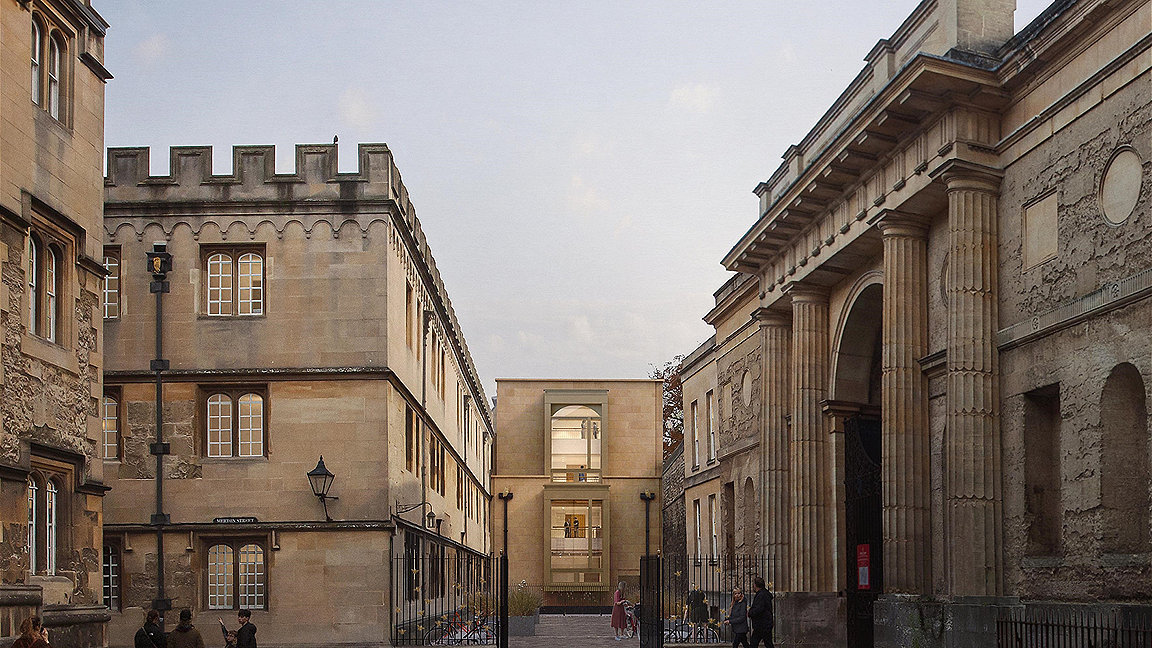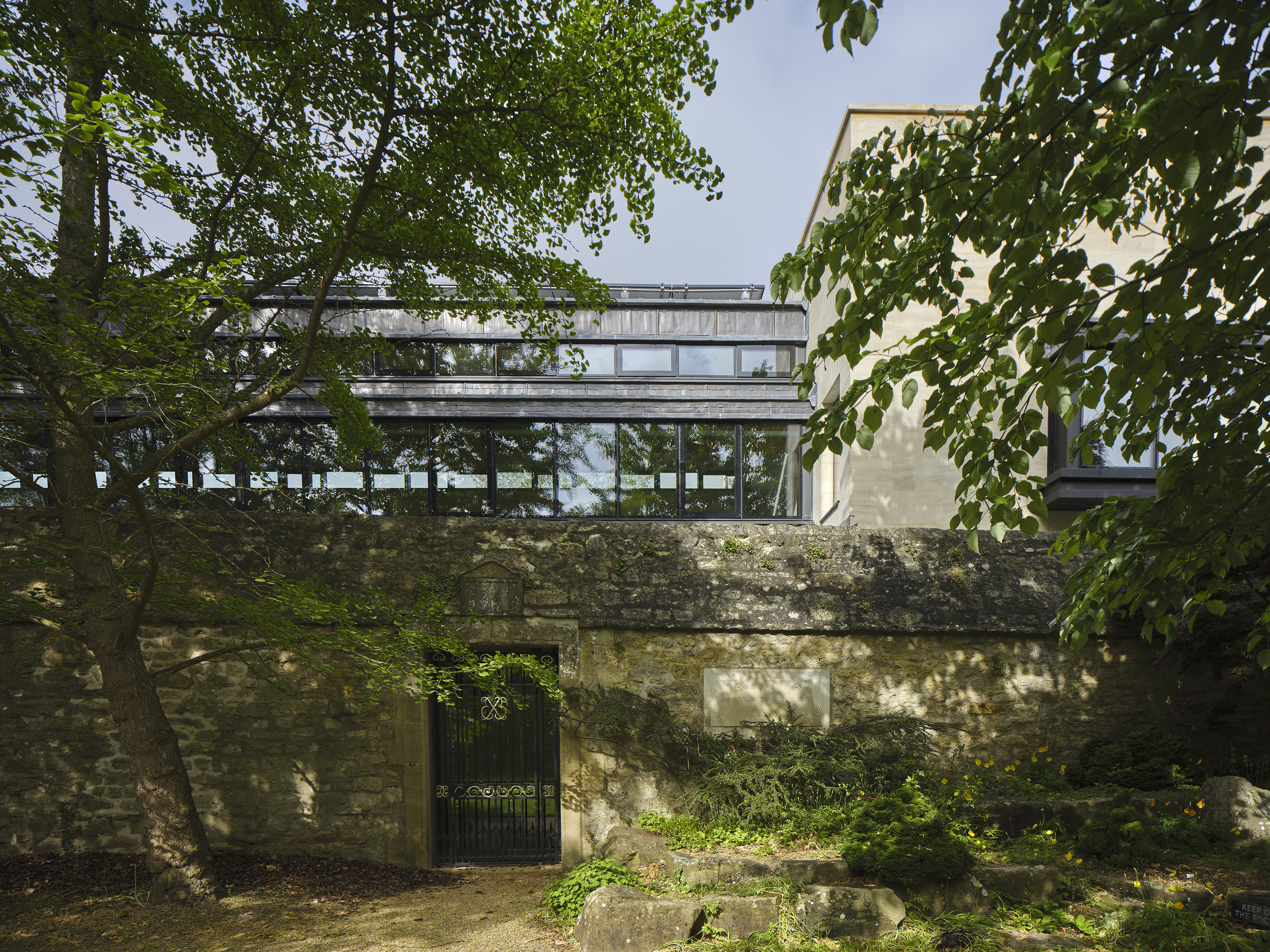
North elevation of University of Oxford's Corpus Christi College, viewed from Oriel Square © Picture Plane
Libraries and archives demand stringent environmental conditions to preserve their collections. If they are not properly designed, they require constantly running ventilation and air conditioning systems to maintain the necessary temperature and relative humidity – which would entail significant energy consumption.
A number of internationally recognised sustainability accreditations for buildings exist and they can be utilised to improve the performance of libraries and archives. While in themselves these do not guarantee a sustainable building – and should be considered critically before being adopted – they provide a framework to support forward-thinking, sustainable building practices that go beyond the mandatory government standards.
For instance, zero-carbon design, BREEAM and Passivhaus are often used in the construction industry to measure the sustainability of a project. Through careful consideration, Wright & Wright Architects has adopted these techniques on several library projects, including those at St John's and Corpus Christi Colleges, Oxford, and Lambeth Palace Library in London.
St John's library designed for zero carbon
Work began on site in 2016 – and was completed in 2019 – with a major new library and study centre for the University of Oxford's St John's College designed to achieve net-zero carbon, at the college's instruction. The project sought to reduce the required operating energy as far as possible at design stage, and offset the remaining carbon through the use of renewable energy.
The 1,940m2 building incorporates a number of sophisticated passive environmental control measures designed to reduce its energy consumption. It has a high thermal mass with an emphasis on natural ventilation and daylighting, while an arterial system of ducts and tunnels funnel air through the concrete mass to heat and cool spaces.
Separate heating and cooling are provided by water from ground-source boreholes under the adjacent Great Lawn, while photovoltaic panels that are either hidden behind parapets or integrated into the central mono-pitched roof contribute to electricity generation.
Such measures are designed to offset the building's carbon emissions fully, to ensure new and old buildings are alike carbon-neutral. Archives in the basement meet the exemplary conservation standards of BS 4971, which is dedicated to library collection care, and are regulated by simple conservation heating and cooling.

East elevation of University of Oxford's St John's College library and study centre, viewed beyond Sprott’s Wall © Dennis Gilbert / VIEW
Passivhaus principles followed at Corpus Christi
Around the time the St John's project was being completed, Wright & Wright was commissioned by Corpus Christi College, also in Oxford, to design a new special collections centre and library. This is due to be completed in spring 2024.
The innovative scheme is designed to achieve rigorous Passivhaus standards of construction, energy use and environmental control, a methodology that the University of Oxford's estates department adopted in 2017 to guide its projects.
To achieve this, the building must be designed to an energy demand threshold of 15kWh/m2 a year – a much tougher target than the RIBA 2030 Climate Challenge strategy, which sets a 35kWh/m2 annual threshold.
Wright & Wright's design team has adopted the key Passivhaus principles, namely:
-
providing high levels of insulation
-
omitting thermal bridges
-
specifying high-performance, triple-glazed windows with insulated frames
-
ensuring airtight building fabric
-
designing a mechanical ventilation system with highly efficient heat recovery.
Rigorous construction auditing systems ensure that sustainability targets are achieved through high-quality construction.
Approved Document L updates
The updates to Approved Document L: Conservation of fuel and power – that came into effect on 15 June 2022 – appear to bring it further in line with Passivhaus principles, although they are not as stringent. One of the biggest additions to the approved document is the inclusion of primary energy calculations that assess factors including the efficiency of heating systems and the energy required to produce and deliver fuel.
As work on the Corpus Christi project had already commenced on site when the updated approved document came into effect, there was therefore no obligation to comply as it had received planning permission and Building Regulations approval under the previous regulation. Nevertheless, the College's decision to adhere to the more onerous requirements of Passivhaus means that the project does comply with the new regulation.
Efficiency is measured in terms of kilowatt-hours used per square metre per year or, more simply, how much primary energy is required by area to operate the building each year – a metric that will be familiar to those who have worked on a Passivhaus design.
The updated approved document also focuses on improving thermal envelopes, and the performance efficiency required for all external elements such as walls, windows, doors and roofs has been increased.
Project conserves palace collections and garden
The new Lambeth Palace Library, completed in 2020 and opened to the public in 2021, was awarded a BREEAM rating of Excellent, a requirement of the Lambeth Local Plan.
The library's layout is designed to minimise the building's footprint and enhance the local ecology; it acts as a barrier between the grounds and Lambeth Road, significantly reducing noise and air pollution in the palace garden while accommodating a new and enlarged pond and wetland glade.
The result is a low-carbon building that uses its structure and fabric to regulate the environment in the archive stores and avoid the need for expensive and complex air conditioning. The building is also fully electric, with its energy demand being met by photovoltaic panels mounted on the lower roofs flanking the central tower. As with the other two projects highlighted above, the Part L legislation is too new to have had a direct impact on Lambeth Palace Library.

Lambeth Palace Library © Hufton + Crow
Looking to the legislation – and beyond
In response to the latest Approved Document L requirements, BREEAM has updated some of its assessments on electricity and heating. While these form part of what is an extensive methodology, it could be argued that the role of accreditations is to improve the built environment and encourage brave, pioneering design rather than merely keeping pace with regulations.
It is imperative that buildings generate less carbon during their construction and require less energy to run. This is especially important for libraries, given the demanding environmental conditions that must be maintained.
The climate crisis is challenging the way architects design, and although the regulations are moving in the right direction there is still a considerable amount of work to be done. Many local authorities and stakeholders are demanding that projects go above and beyond the mandatory regulations.
Yet the updates to Approved Document L are an encouraging move towards meeting the government's commitment to reduce greenhouse gas emissions to net zero by 2050. By establishing and meeting targets that went beyond the legislation in place at the time, these libraries demonstrate progressive design principles and are exemplars in sustainability.
'It could be argued that the role of accreditations is to improve the built environment and encourage brave, pioneering design rather than merely keeping pace with regulations'
Kirsty Shankland is an associate and Passivhaus designer at Wright & Wright Architects
Contact Kirsty: Email
Related competencies include: Sustainability
RICS champions sustainability across professions
With the built environment estimated to be responsible for around 40% of global carbon emissions, RICS is championing sustainable practices across the built and natural environment. We are also empowering professionals to embed sustainability considerations into the way they work and better measure environmental impacts.


